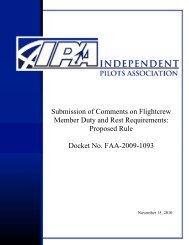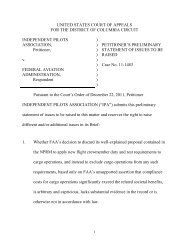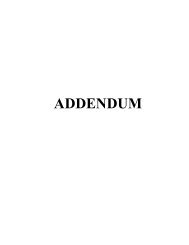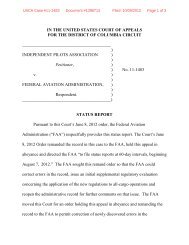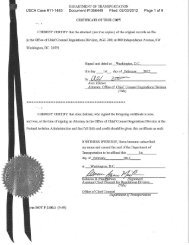Exhibits Vol 2 - Independent Pilots Association
Exhibits Vol 2 - Independent Pilots Association
Exhibits Vol 2 - Independent Pilots Association
You also want an ePaper? Increase the reach of your titles
YUMPU automatically turns print PDFs into web optimized ePapers that Google loves.
scientific correspondence<br />
ber in parentheses is the estimated error in<br />
the last digit). As Woodcock correctly<br />
points out, the calculation of the relative<br />
stability of the f.c.c. and h.c.p. phases of<br />
hard spheres is a long-standing problem in<br />
statistical physics. Attempts to resolve it<br />
date back to the work of Alder, Hoover and<br />
colleagues 2–5 , and most recently, a direct<br />
simulation by Frenkel and Ladd 6 , obtaining<br />
the bounds of Helmholtz free-energy of<br />
0.001ΔF * 0.002. Woodcock’s estimate<br />
is incompatible with this latter result.<br />
To resolve this issue, we made accurate<br />
calculations of the free-energy difference<br />
between h.c.p. and f.c.c. hard-sphere crystals<br />
both at the melting density (73.6% of<br />
the density of regular close packing) and at<br />
close packing, using two different methods.<br />
We find that ΔF * 0.0009(2) at melting, a<br />
result that is quite consistent with the earlier<br />
work, but is five times smaller than<br />
Woodcock’s estimate. Woodcock does not<br />
explain how he arrives at an error estimate<br />
of 20% — our work suggests that the<br />
numerical error in his result must have<br />
been four times larger than the entire<br />
h.c.p.f.c.c. free-energy difference.<br />
Nevertheless, we do agree with the sign<br />
of Woodcock’s estimate — the f.c.c. crystal<br />
is indeed more stable than the h.c.p. crystal.<br />
This might explain the tendency towards<br />
f.c.c. packing seen in some experimental<br />
studies of hard-sphere colloids 7 . In one set<br />
of simulations, we used the ‘Einstein-crystal’<br />
method 6,8 , simulating crystals of 12,096<br />
hard spheres (slightly larger than the largest<br />
system studied by Woodcock), and computed<br />
the Helmholtz free-energies of the two<br />
phases using a 20-point Gauss–Legendre<br />
quadrature. Every point in this quadrature<br />
involved a Monte Carlo simulation of 10 5<br />
trial moves per particle, excluding equilibration.<br />
We find that the free-energy difference<br />
between h.c.p. and f.c.c. at melting is<br />
ΔF * 0.00087(20), and at close packing<br />
ΔF * 0.00094(30). The statistical error was<br />
computed on the basis of the variance in the<br />
block averages of the individual Monte<br />
Carlo runs 9 .<br />
We also performed simulations using a<br />
new ‘multi-hamiltonian’ method (S.-C. M.<br />
and D. A. H., manuscript in preparation)<br />
that directly equilibrates the h.c.p. and f.c.c.<br />
hard-sphere crystals with each other by a set<br />
of intermediate states with different interactions<br />
but essentially the same free-energy.<br />
These latter simulations were done on<br />
much smaller samples (64 to 512 spheres)<br />
and obtained essentially the same freeenergy<br />
differences (for 512 spheres,<br />
ΔF * 0.00085(10) near melting, and<br />
0.0011(2) at close packing) as the ‘Einsteincrystal’<br />
simulations, with comparable statistical<br />
errors. Statistically significant<br />
finite-size effects were detected only for the<br />
smallest size (64 spheres) near melting,<br />
where ΔF * dropped to near zero.<br />
In any event, our result for the<br />
f.c.c.–h.c.p. free-energy difference for large<br />
hard-sphere crystals at melting is much<br />
closer to ΔF * =0, proposed almost 30 years<br />
ago by Alder and co-workers, than to the<br />
recent estimate by Woodcock.<br />
P. G. Bolhuis, D. Frenkel<br />
FOM Institute for Atomic and Molecular Physics,<br />
Kruislaan 407, 1098 SJ Amsterdam,<br />
The Netherlands<br />
Siun-Chuon Mau, David A. Huse<br />
Department of Physics,<br />
Princeton University,<br />
Princeton, New Jersey 08544, USA<br />
Woodcock replies — I reported the discovery<br />
a substantial area of pressure difference<br />
(P) between the f.c.c. and h.c.p. singleoccupancy-cell<br />
models, which arises from a<br />
difference in order–disorder transition<br />
pressures. The result was a free-energy difference<br />
in favour of f.c.c., corresponding to<br />
an entropy difference 0.005Nk B , over the<br />
range V1.00N 3 to 1.25N 3 , with a generous<br />
uncertainty (± 0.001), estimated by<br />
integrating the standard deviations of subaverages<br />
of P for individual data points.<br />
Extension of the computations on either<br />
side of the phase transition have since<br />
revealed a tail in the pressure difference for<br />
V1.25N 3 in favour of h.c.p. There is also<br />
a weak pressure difference for volumes<br />
below melting. I have now obtained more<br />
accurate data for these tails, including new<br />
data points on both sides of the singleoccupancy-cell<br />
phase transition (Fig. 1).<br />
I did not originally calculate the pressure<br />
difference in the stable crystal range, relying<br />
on earlier findings that P up to melting<br />
was not detectable by molecular dynamics<br />
computation 2 , and that these showed the<br />
two crystals to have indistinguishable crystal<br />
constants C 0 and C 1 (ref. 4). Consequently I<br />
assumed no difference between the Gibbs<br />
and Helmholtz free-energies in the stable<br />
Figure 1 Latest molecular dynamic data for the<br />
pressure difference as a function of volume at constant<br />
temperature, P(V) T , between the h.c.p. and<br />
f.c.c. single-occupancy-cell crystal structures for<br />
hard spheres; V 0 is the close-packed crystal volume<br />
and V m is the volume at melting. The area under<br />
this curve is the Helmholtz free-energy difference<br />
between the two crystal structures at close packing<br />
in units of Nk B T.<br />
crystal range.<br />
A detectable pressure difference between<br />
f.c.c. and h.c.p. crystals below melting,<br />
however, has now been computed, both by<br />
R. Speedy (personal communication) and<br />
myself. This small pressure difference<br />
means that the entropy difference at<br />
constant volume — which equals the<br />
Helmholtz free-energy difference for hard<br />
spheres — is not the same as the Gibbs freeenergy<br />
difference, which determines the stable<br />
crystal structure at freezing. However,<br />
the correction is small, ~0.000015Nk B T.<br />
At the melting volume (V m ) of 0.96N 3 ,<br />
I calculate the pressure difference to be<br />
0.0030(5)k B T/ 3 (N12,000). Alder et al. 3<br />
adopted too large a value for P m<br />
(0.02k B T/ 3 ), and further guessed wrongly<br />
that the absolute difference decreased linearly<br />
with density to zero at V 0 . In fact they<br />
estimated the Helmholtz free-energy difference<br />
(F m –F 0 ) to be 0.002Nk B T in favour<br />
of f.c.c. My data (Fig. 1) show that the pressure<br />
difference found at melting actually<br />
decreases to negligible values more rapidly,<br />
and that the change in free-energy difference<br />
between close packing and melting is<br />
of the order 0.0003Nk B T. The closeness of<br />
the result of Alder et al. to any of the present<br />
results, or indeed to zero, is therefore an<br />
irrelevance.<br />
The Einstein-crystal method 10 (used<br />
both by Frenkel and Ladd 6 and here by Bolhuis<br />
and Frenkel), the multi-hamiltonian<br />
method and the Hoover–Ree single-occupancy-cell<br />
method, if accurately implemented,<br />
should all give the correct answer. I<br />
am still working on this problem, but the<br />
latest result for the Helmholtz free-energy<br />
difference between the h.c.p. and f.c.c.<br />
structures (f.c.c. having the lower freeenergy)<br />
at close packing gives:<br />
F 0 ∞<br />
(P hcp P fcc )dV0.0026±0.001Nk B T.<br />
V 0<br />
The change in Helmholtz free-energy difference<br />
between close-packing and the<br />
melting volume amounts to only<br />
0.0003(1)Nk B T, as shown by the tiny,<br />
positive area in P(V ) T up to the melting<br />
volume (V m ) (see Fig. 1). Hence, the<br />
Helmholtz free-energy difference at the<br />
melting volume is F m 0.0023(10)Nk B T.<br />
There remains a quantitative disagreement<br />
between my result and the other two methods,<br />
but my original conclusion that the<br />
f.c.c. phase is everywhere the more stable<br />
crystal phase for hard spheres is confirmed<br />
by all the new results. It is also gratifying<br />
that the result for the tiny free-energy difference<br />
between close packing and melting<br />
show a remarkable consistency, within the<br />
error bars, by all three methods.<br />
L. V. Woodcock<br />
Department of Chemical Engineering,<br />
University of Bradford, Bradford,<br />
West Yorkshire BD7 1DP, UK<br />
236 NATURE | VOL 388 | 17 JULY 1997<br />
Nature © Macmillan Publishers Ltd 1997



